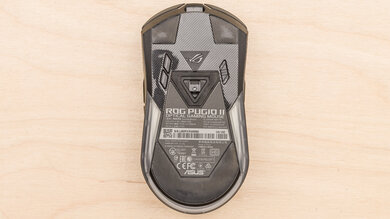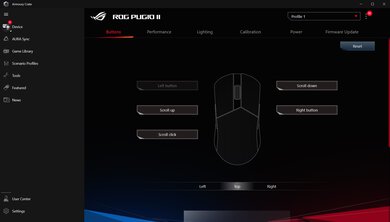The ASUS ROG Pugio II is a good wireless gaming mouse with a symmetrical shape and two buttons on both the left and right sides. It feels very well-built, it's suitable for all grip types and nearly all hand sizes, and you can use it wired or wirelessly, either with its USB receiver or via Bluetooth. It also has a wide CPI range, a very low lift-off distance, and very good click latency. Unfortunately, it's heavy, the companion software is only compatible with Windows, and you can only adjust the CPI by increments of 100.
Our Verdict
The ASUS ROG Pugio II is very good for office work. It feels very sturdy and connects wired or wirelessly either with its USB receiver or via Bluetooth. It also has an impressive number of buttons you can program using the customization software and an ambidextrous shape suitable for all grip types and nearly all hand sizes. Unfortunately, the software is only compatible with Windows, and the scroll wheel lacks L/R tilt buttons and doesn't unlock for free scrolling.
-
Feels very well-built.
-
Comfortable, symmetrical shape with a pair of side buttons on either side.
-
Connects wirelessly with its USB receiver or via Bluetooth.
-
No software for macOS, and the right side buttons don't function by default.
The ASUS ROG Pugio II is a good FPS gaming mouse. It has a sturdy-feeling build, very good click latency, and an ambidextrous shape suitable for all grip types and nearly all hand sizes. It also has a wide CPI range and a very low lift-off distance. Unfortunately, the companion software is only compatible with Windows, and you can only adjust the CPI in increments of 100.
-
Feels very well-built.
-
Low click latency.
-
Comfortable, symmetrical shape with a pair of side buttons on either side.
-
Heavy.
-
CPI only adjustable by increments of 100, and there's no CPI switch button on the top of the mouse.
The ASUS ROG Pugio II is a good mouse for MMO gaming, though it doesn't have as many side buttons as dedicated MMO gaming mice. That said, you can reprogram most of the buttons it does have using the companion software. Otherwise, it feels very well-built, and its ambidextrous shape is suitable for all grip types and nearly all hand sizes. It also has a wide CPI range, a very low lift-off distance, and a low click latency. Unfortunately, the software is only compatible with Windows, and you can only adjust the CPI in increments of 100.
-
Feels very well-built.
-
Low click latency.
-
Comfortable, symmetrical shape with a pair of side buttons on either side.
-
Not as many side buttons as a dedicated MMO mouse.
-
CPI only adjustable by increments of 100, and there's no CPI switch button on the top of the mouse.
The ASUS ROG Pugio II is decent for ultra-light gaming, but it's much heavier than a dedicated ultra-light gaming mouse. Despite this, it feels well-built, and it has an ambidextrous shape well-suited for all grip types and almost all hand sizes. It also has very good click latency when used wired or wirelessly with its USB receiver. Unfortunately, you can only adjust the CPI by increments of 100, and while the mouse feet are decent, they're not as good as those on most other high-end wireless gaming mice.
-
Feels very well-built.
-
Low click latency.
-
Heavy.
-
Mouse feet don't glide as smoothly as many similar gaming mice.
The ASUS ROG Pugio II is an impressive mouse for traveling, though it's somewhat bulky and may not fit in all laptop cases. It connects wirelessly, either with its USB receiver or Bluetooth, its shape is well-suited for all grip types and nearly all hand sizes, and it feels sturdy. It also has storage for its wireless receiver and onboard memory. Unfortunately, the companion software is only compatible with Windows.
-
Feels very well-built.
-
Comfortable, symmetrical shape with a pair of side buttons on either side.
-
Connects wirelessly with its USB receiver or via Bluetooth.
-
Onboard memory.
-
Somewhat bulky; may not fit in some laptop cases.
-
No software for macOS, and the right side buttons don't function by default.
- 8.1 Office/Multimedia
- 7.7 Video Games (FPS)
- 7.4 Video Games (MMO)
- 7.0 Ultra-Light Gaming
- 8.3 Travel
- Updated Jul 08, 2021: Review published.
- Updated Jun 14, 2021: Early access published.
- Updated May 17, 2021: Our testers have started testing this product.
- Updated May 13, 2021: The product has arrived in our lab, and our testers will start evaluating it soon.
- Updated Apr 17, 2021: We've purchased the product and are waiting for it to arrive in our lab.
Differences Between Sizes And Variants
The ASUS ROG Pugio II is an updated, wireless version of the ASUS ROG Pugio. The unit we tested is black, and there are no other color variants. You can see the label for our unit here.
Compared To Other Mice
The ASUS ROG Pugio II is an update of the ASUS ROG Pugio. It retains the ambidextrous design of the original, with a symmetrical body and a pair of side buttons on either side, but it adds wireless capabilities. Additionally, it has an updated look, a new PAW 3335 sensor, and Bluetooth support, which the similar ASUS ROG Strix II lacks. Like many other ASUS ROG mice, though, this mouse also has hot-swappable switches, so you can install an alternate set to suit your preferences.
For more recommendations, see our picks for the best mouse, the best gaming mouse, and the best wireless mouse.
The Razer Viper Ultimate is a better wireless gaming mouse than the ASUS ROG Pugio II. It's significantly lighter and has much lower click latency. It also has mouse feet that glide more smoothly, a higher maximum CPI, and a more precisely adjustable CPI. Its shape is best-suited for a fingertip grip for larger hands or a claw or palm grip for smaller hands. Comparatively, the ASUS feels sturdier and has Bluetooth support. It also has hot-swappable switches for the left and right-click buttons. Its shape is well-suited for all grip types and nearly all hand sizes.
The ASUS ROG Keris Wireless is a better wireless gaming mouse than the ASUS ROG Pugio II. It's significantly lighter, and it has both a more flexible charging cable and mouse feet that glide more smoothly. Also, it has a much lower click latency. On the other hand, the Pugio II has two additional side buttons on the right side and a lower lift-off distance. Both mice connect wirelessly either with their USB receivers or via Bluetooth. They also both have hot-swappable switches for the left and right-click buttons.
The ASUS ROG Pugio II has somewhat better gaming performance than the ASUS ROG Chakram, but the Chakram is more versatile. The Pugio II is lighter and has a pair of side buttons on either side. Comparatively, the Chakram has a thumb rest and two buttons on the left side, plus a joystick that acts either as an analog stick or a four-direction D-pad. Both mice connect wired or wirelessly, either with their USB receivers or via Bluetooth. Also, they both have hot-swappable switches for the left and right-click buttons.
The Logitech G502 LIGHTSPEED and the ASUS ROG Pugio II are good wireless gaming mice. The Logitech has a thumb rest, a more flexible cable, and several extra buttons. It also has a higher maximum CPI, a more adjustable CPI, a more consistent sensor, a lower click latency, and software for Windows and macOS. Comparatively, the ASUS has Bluetooth support and side buttons on the right side, making it better for left-handed users. It also has hot-swappable left and right-click switches. Both mice are well-suited for all grip types, but the Logitech isn't as well-suited for smaller hands.
The GLORIOUS Model O Wireless has better gaming performance than the ASUS ROG Pugio II, but it's less versatile. The GLORIOUS has a honeycomb body, making it much lighter, but it feels just as sturdy. It also has a much more flexible charging cable and mouse feet that glide more smoothly. Performance-wise, it has a higher maximum CPI, a more precisely adjustable CPI, and better click latency. On the other hand, the ASUS has two additional side buttons on the left and Bluetooth support, which the GLORIOUS lacks. It also has internal storage for its USB receiver and hot-swappable left and right-click switches.
The GLORIOUS Model D is an excellent ultra-light gaming mouse, while the ASUS ROG Pugio II is a good wireless gaming mouse. The GLORIOUS is wired-only and significantly lighter. It has a much more flexible cable, mouse feet that glide more smoothly and lower click latency. Comparatively, the ASUS connects wired or wirelessly with its USB receiver or Bluetooth. Additionally, it feels sturdier and has two extra side buttons. It also has a wider CPI range, a lower lift-off distance, and hot-swappable left and right-click switches. Both mice are well-suited for all grip types and nearly all hand sizes.
The Logitech G Pro Wireless is a better wireless gaming mouse than the ASUS ROG Pugio II. It's significantly lighter and has mouse feet that glide more smoothly. It also has a much higher maximum CPI, a more precisely adjustable CPI, a more consistent sensor, and a much lower click latency. It also has software compatible with Windows and macOS. Comparatively, the ASUS has two additional side buttons, hot-swappable left and right-click switches, and Bluetooth support. Unfortunately, its software is only compatible with Windows. Both mice are well-suited to all grip types for nearly all hand sizes.
Test Results
ASUS claims up to 69 hours of battery life for the ASUS ROG Pugio II without RGB lighting enabled when connected with its USB receiver, or up to 100 hours without RGB while connected via Bluetooth. However, this isn't something we test.
The available polling rate options on the ASUS ROG Pugio II are 125Hz, 250Hz, 500Hz, and 1000Hz. Also, while connected via Bluetooth, the polling rate is locked at 125Hz.
The ASUS ROG Pugio II has hot-swappable switch sockets for the left and right mouse buttons. Also, the side buttons are mounted magnetically, and there's an alternate pair included for each side. There's also a dedicated button on the underside to cycle between CPI profiles.













